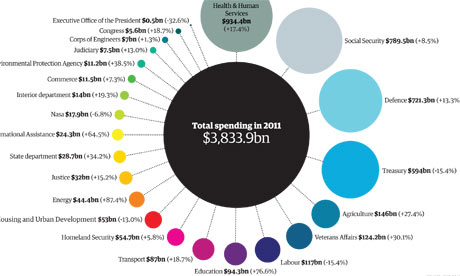Obama's 2011 budget: US public spending by department since 1962
Barack Obama's second budget is already controversial. Find out what it means for each department, how it compares to George Bush's last one - and how it's changed since 1962
• Get the data
Obama's 2011 budget: US public spending by department since 1962
Barack Obama's second budget is already controversial. Find out what it means for each department, how it compares to George Bush's last one - and how it's changed since 1962
• Get the data

 Obama's 2011 budget: click on image to see at full size
Obama's 2011 budget: click on image to see at full sizeAfter a while they just appear to be unimaginably big numbers. By early 2011, the US government will have spent $3.8 trillion in one year.
President Barack Obama projected the US budget deficit would peak at a new record in 2010 - before easing as he pushes for fiscal responsibility while battling double-digit unemployment. "We won't be able to bring down this deficit overnight, given that the recovery is still taking hold," Obama said, laying out $3.8 trillion in spending plans for the fiscal year to end of September, 2011.
It's not set in stone - Congress has the power to change it. It also forcasts a $1.56 trillion deficit in 2010. That's or 10.6% of the economy measured by gross domestic product (GDP). This funding gap was forecast to dip to $1.27 trillion in 2011, or 8.3 percent of GDP, and fall to roughly half that as a share of the economy in the final year of Obama's term in 2012, meeting a key pledge.
So what does that mean for US public spending - besides cuts for Nasa? We've extracted the key figures from the White House Office of Management and Budget. It shows spending by department back to 1962 - and ahead to 2015. The summary is below but click on the spreadsheet link for the full data.
We've worked out the changes since bush's last budget - the 2009 figures. What can you do with it?
Download the data
• DATA: download the full datasheet, 1962-2015
World government data
• Search the world's government with our gateway
Can you do something with this data?
Flickr Please post your visualisations and mash-ups on our Flickr groupor mail us at datastore@guardian.co.uk
• Get the A-Z of data
• More at the Datastore directory
• Follow us on Twitter
Data summary
FY 2011 Military Budget
By Kimberly Amadeo, About.com Guide
FY 2011 Defense Department Base Budget:
Total Defense Spending:
Total defense spending requested for FY 2011 was $895 billion. This was more than the total defense budget request of $855 billion for FY2010, and the total budget request for Security and the War on Terror request of $782 billion in FY 2009. (Source: OMB, Table S-4.)
What Does the 2011 Military Budget Focus On?:
The budget reviewed acquisitions and defense technology development to eliminate waste by 17% through 2011. It ended or reduced several programs, including the C-17 aircraft, the Joint Strike Fighter Alternate Engine program, the Third Generation Infrared Surveillance program, and the Net-Enabled Command Capability program. It supported a reconfigured ballistic missile defense
Military Budget Related Articles
Related Articles
- US Federal Budget Primer - Impact of US Federal Budget and Deficit on the U...
- US Economy, - Profiles
- FY 2010 US Military Budget
- US Federal Budget Primer - The Impact of the FY 2008 US Federal Budget on t...
- US Budget and Spending Primer - A Description of the US Budget as it Relate...
- http://useconomy.about.com/od/usfederalbudget/p/military_budget.htm
2011 United States federal budget
| ‹ 2010 · | |
| Submitted | February 1, 2010 |
|---|---|
| Submitted by | Barack Obama |
| Submitted to | 111th Congress |
| Passed | Passed by House of Representatives, but not by Senate |
| Total revenue | $2.17 trillion (estimated) |
| Total expenditures | $3.82 trillion (estimated) |
| Deficit | $1.65 trillion (estimated) |
| Website | US Government Printing Office |
The United States Federal Budget for Fiscal Year 2011, is a spending request by PresidentBarack Obama to fund government operations for October 2010–September 2011. Figures shown in the spending request do not reflect the actual appropriations for Fiscal Year 2011, which must be authorized by Congress. The budget did not pass this year, the first time since 1974,[1] and on September 30, 2010, the Congress voted on a continuing resolution, to keep the government running until December 3, 2010. On December 22, 2010, the Congress voted on another continuing resolution, to keep the government running until March 4, 2011, [2].
Contents[hide] |
[edit]Overview
President Barack Obama proposed his 2011 budget during February 2010. He has indicated that jobs, health care, clean energy, education, and infrastructure will be priorities. Total requested spending is $3.83 trillion and the federal deficit is forecast to be $1.56 trillion in 2010 and $1.27 trillion in 2011. Total debt is budgeted to increase from $11.9 trillion in FY2009, to $13.8 trillion in FY2010, and $15.1 trillion in FY2011.[3][4]
For 2011, the Congressional Budget Office (CBO) projects that if current laws remain unchanged, the federal budget will show a deficit of close to $1.5 trillion, or 9.8 percent of GDP. The CBO projects total revenues of $2.228 trillion and total outlays of $3.708 trillion for a deficit of $1.48 trillion for 2011. The deficits in CBO's baseline projections drop markedly over the next few years as a share of output and average 3.1 percent of GDP from 2014 to 2021. Those projections, however, are based on the assumption that tax and spending policies unfold as specified in current law. Consequently, they understate the budget deficits that would occur if many policies currently in place were continued, rather than allowed to expire as scheduled under current law. [5]
On February 14, 2011, President Obama released his 2012 Federal Budget. The report updated the projected 2011 deficit to $1.645 trillion. This is based on estimated revenues of $2.173 trillion and outlays of $3.818 trillion. [6]
[edit]Total spending
The projected gross domestic product is listed at $15.3 trillion and the projected population for 2011 is shown as 311.6 million.[7]
The federal budget for 2011 is projected at $3.83 trillion in total spending.[7] This is to include: $787.6 billion in pensions, $898 billion in health care expenditures, $140.9 billion for education, $928.5 billion in defense spending, $464.6 billion in welfare spending, $57.3 billion in protective services such as police, fire, law courts, $104.2 billion for transportation, $29 billion in general government expenses, $151.4 billion in other spending including basic research, and $250.7 billion on interest payments.[7]
[edit]Major initiatives
The following major changes were proposed to federal programs:
- The Bush tax cuts in 2001 and 2003 would be allowed to expire for individuals earning over $200,000 and families earning over $250,000. However in December of 2010 congress along with President Obama struck a deal to extend the said Bush tax cuts for another two years through the 2012 fiscal year. Current tax rates would remain as is for everyone across the board but payroll taxes would be lowered and the social security tax would be lowered by two percentage points.
- Banks would face a $90 billion tax in total over 10 years.
- The budget proposes NASA's Constellation program to continue, but in a new direction including technology programs, increased R&D spending, a focus on the International Space Station and contracting out flying crew to space to commercial providers.
- The budget contains $4 billion for the creation of a national infrastructure bank called the "National Infrastructure Innovation and Finance Fund."[8] This proposal is similar to the National Infrastructure Reinvestment Bank initiative previously proposed by Congress.
- The budget would cut $40 billion of tax subsidies for oil, gas and coal companies over the next decade.[9]
- The Research & Experimentation Tax Credit would be made permanent.[10]
- Appropriates $36 Billion to the Department of Energy to distribute in loan guarantees for construction of new nuclear power plants and reactors. As part of the Energy Policy Act of 2005, this appropriation is to provide funding for 80% of the total cost of construction at approved nuclear sites in the coming years www.world-nuclear.org.[11]
[edit]References
- ^ http://thehill.com/blogs/on-the-money/budget/92237-house-has-passed-budget-resolution-every-year-since-budget-act-according-to-study
- ^ http://appropriations.house.gov/index.cfm?FuseAction=PressReleases.Detail&PressRelease_id=246
- ^ Runningen, Roger (2010-02-01). "Retrieved 2010-02-01 Bloomberg". Bloomberg.com. Retrieved 2010-08-27.
- ^ "OMB-2011 Budget-Summary Table S-3" (PDF). Retrieved 2010-08-27.
- ^ http://www.cbo.gov/ftpdocs/120xx/doc12039/SummaryforWeb.pdf | CBO Budget and Economic Outlook: FY 2011 to 2021
- ^ http://www.whitehouse.gov/omb/budget/Historicals | OMB Budget Tables
- ^ a b c Chantrill, Christopher. "Highlights of US Federal Budget for FY11". Government Spending in the United States of America. Retrieved October 19, 2010.
- ^ White House Budget Seeks $4B for Transportation Infrastructure Bank. Josh Voorhees. 2010-02-01. The New York Times. Retrieved 2010-02-04.
- ^ White House Budget Proposal Gives Ax to Fossil Fuel Tax Breaks, Some Interior Programs. Allison Winter, Darren Samuelsohn. 2010-02-01. The New York Times. Retrieved 2010-02-05.
- ^ "Federal Budget Fiscal Year 2011 - Fact Sheet on Innovation". Office of Management and Budget. 2010. Retrieved 2010-06-15.
- ^ US Nuclear Power Policy - http://www.world-nuclear.org/info/inf41_US_nuclear_power_policy.html
[edit]External links
| | Wikinews has related news:Obama announces US$3.8 trillion 2011 budget plan for US |
- Official Government Printing Office 2011 Budget page
- Congressional Budget Office
- Charlie Rose-2011 Budget Discussion with Bayh, Gregg, and Altman
- http://www.world-nuclear.org/info/inf41_US_nuclear_power_policy.html
| |||||
| RelatedTimeline of articles Number of sources covering this story
ImagesVideos |
Pl Read:
http://nandigramunited-banga.blogspot.com/































No comments:
Post a Comment